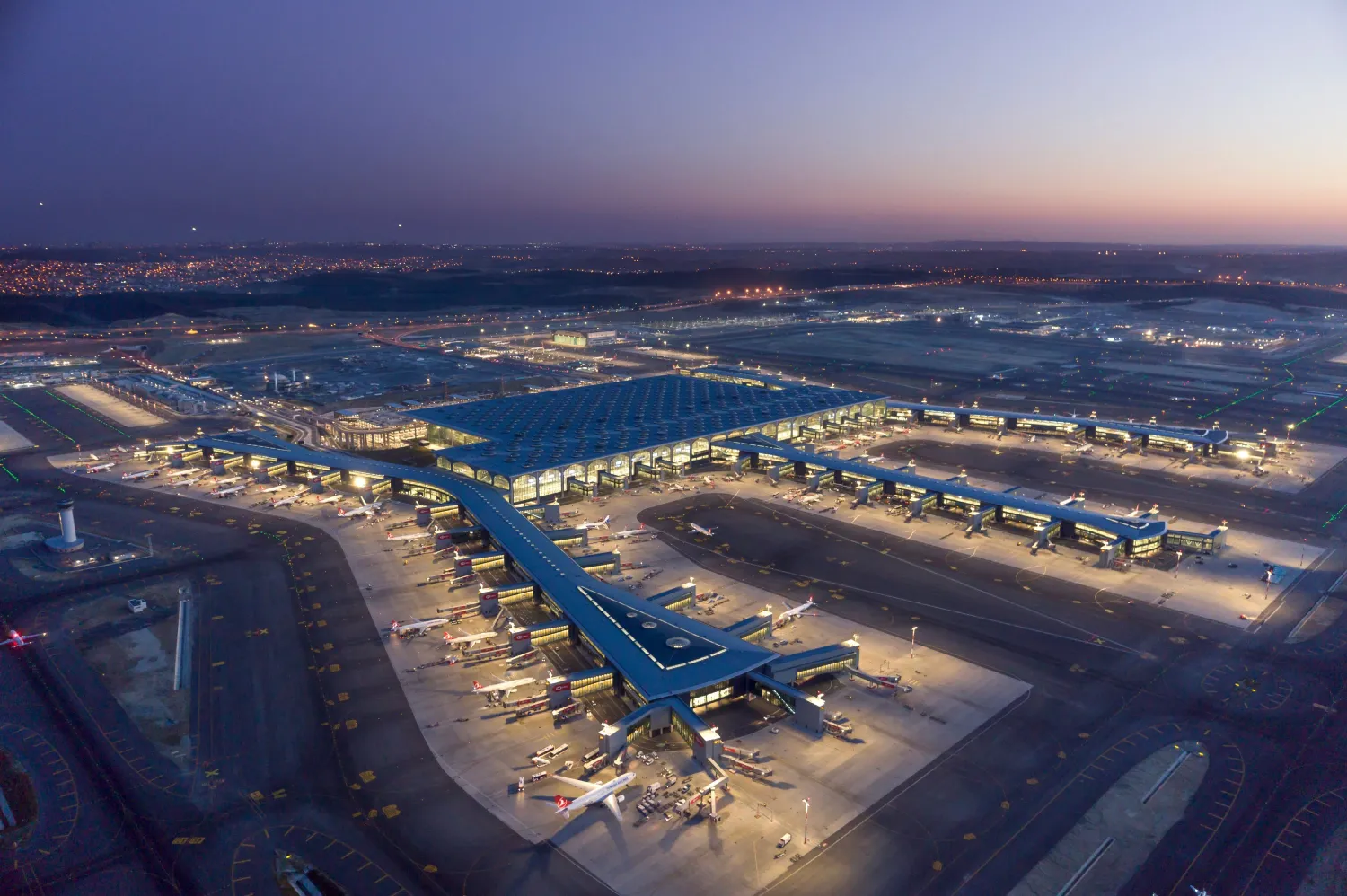
The Ultimate Guide to Transportation in Turkey & Istanbul International Airport 2025
Table of Contents
Turkey—particularly Istanbul—has witnessed an impressive transformation in its transportation infrastructure, making it one of the most connected and accessible cities in Europe and the Middle East. With the opening of Istanbul International Airport (IST), the Turkish transport system now combines efficiency, speed, and smart technologies designed to serve tourists, residents, and real-estate investors alike.
Whether you are a local resident, a tourist, or a property investor looking for projects close to public transport, this 2025 guide provides everything you need to know about transportation in Turkey and the best ways to reach Istanbul Airport.
Overview of Turkey’s Transportation Sector
Turkey’s unique geographic position—linking Europe and Asia—makes it a natural bridge between continents. This strategic location has given the transportation sector a vital role in supporting the national economy and facilitating regional and international trade.
The Ministry of Transport and Infrastructure (Ulaştırma ve Altyapı Bakanlığı) oversees the development and management of all transportation networks, including highways, railways, civil aviation, and seaports. These efforts are part of Turkey’s “2053 Vision for Transport and Logistics,” a national plan to build an integrated, smart, and sustainable mobility system connecting all major cities and industrial zones.
Land Transport and Highways
Turkey boasts one of the most advanced road networks in the region, with over 70,000 km of paved roads, including 30,000 km of dual carriageways linking major cities and industrial hubs.
The network is managed by the General Directorate of Highways (KGM) and funded through large-scale national programs aimed at improving efficiency and reducing travel times.
Key strategic projects include:
- Istanbul–Izmir Highway (O-5): Reduced travel time between the two cities from 8 hours to approximately 3.5 hours, boosting tourism and trade.
- Osman Gazi and Yavuz Sultan Selim Bridges: Among the largest in the world, designed to ease congestion across the Bosphorus and strengthen intercontinental connectivity.
- Electronic Toll Systems (HGS & OGS): Enable automatic toll payments without stopping, reducing traffic and improving flow.
- Land transport remains the backbone of domestic mobility in Turkey, accounting for over 90% of passenger and cargo movement, thanks to its quality infrastructure and accessibility to major ports and cities.
Public Transportation in Istanbul – A Comprehensive Network
Istanbul features one of the most extensive public transport systems in the world, consisting of:
- Metro: A wide network spanning both the European and Asian sides, including the new M11 Airport Line directly linking to Istanbul Airport.
- Tram: A convenient option for reaching historical areas like Sultanahmet and Beyoglu.
- Buses (IETT): Cover all districts and operate around the clock.
- Ferries: Offer a scenic way to cross between the city’s two continents via the Bosphorus.
IstanbulKart – The Smart Transport Card
IstanbulKart is the official payment method for all public transportation. It can be purchased at metro stations, bus stops, or the airport, and is rechargeable and shareable among users.
Tip: Always keep your card topped up—it offers discounted fares and seamless transfers across all modes of transport.
Istanbul International Airport (IST) – Turkey’s Global Gateway
Officially opened in 2018, Istanbul International Airport replaced Atatürk Airport and has become one of the largest and most advanced airports in the world.
It is operated by the İGA consortium under the supervision of the Ministry of Transport and Infrastructure, as part of Turkey’s vision to make Istanbul a global aviation hub.

Infrastructure and Capacity
Designed to handle over 200 million passengers annually once all phases are completed.
Spanning 76.5 million square meters, featuring 5 runways and 4 main passenger terminals with cutting-edge security and automation systems.
Recipient of major awards, including “Best Airport in Europe 2023” by ACI Europe.
Transportation To & From the Airport
Istanbul Airport offers multiple convenient transport options connecting it to all parts of the city:
- Metro Line M11 (Gayrettepe – Istanbul Airport – Halkali): Direct connection to the city’s metro network.
- HAVAIST Luxury Buses: Provide comfortable rides to over 60 destinations across Istanbul.
- IETT Public Buses: Affordable options for local travelers.
- Taxis & Digital Apps: Services like Uber and BiTaksi offer fast, flexible transfers.
- D020 Highway: Provides direct access to the northern Istanbul bridges and national highway network.
Airport Facilities
Istanbul Airport offers a world-class travel experience with premium facilities, including:
- Electric buggies for elderly passengers and those with mobility needs.
- Spacious prayer areas and mosques.
- YOTEL Istanbul Airport Hotel, offering luxury accommodation within the terminal.
- Extensive duty-free shopping zones featuring top international brands.
Real-Estate Investment & Transportation
- Proximity to public transportation is a major factor in determining a property’s market value and rental yield.
- Developments near metro lines or airports experience steady price growth and high demand.
- Areas such as Göktürk, Topkapı, Başakşehir, and Kağıthane have gained strong investment appeal thanks to new transport links connecting them directly to the airport and business districts.
- For foreign investors, easy access to IST Airport ensures greater convenience in travel, property management, and guest reception.
Investment Tip: Properties located within 1 km of a metro station or main highway typically record an annual value growth rate between 7% and 12%.
Top 10 Neighborhoods in Istanbul for Property Investment
Tips for Residents & Travelers
- Use apps like Moovit or Trafi for real-time navigation and route planning.
- Avoid rush hours (7:30–9:30 AM and 5:00–7:30 PM).
- Always recharge your IstanbulKart before long trips.
- Frequent commuters can benefit from monthly transport passes at discounted rates.
- For smooth airport transfers, book private or luxury transport in advance to avoid congestion.
Conclusion
In 2025, Turkey’s transportation system stands as a global model of efficiency and modernity. From the expanding Istanbul Metro to the state-of-the-art international airport, traveling across the country has never been faster, safer, or more comfortable.
For real-estate investors, location near transportation networks is no longer just a convenience—it’s a strategic advantage that ensures higher returns and an elevated living experience.
Easy mobility = Higher value + Better lifestyle + Successful investment.
Frequently asked questions
Turkey is undergoing significant development in its road, metro, and aviation networks as part of its 2053 Transportation Vision, making intercity travel faster and more efficient than ever before.
The Turkish Ministry of Transport and Infrastructure (Ulaştırma ve Altyapı Bakanlığı) manages and develops all land, air, and sea transportation projects in the country.
Among the most prominent is the Istanbul-Izmir highway (O-5), which has reduced travel time to just 3.5 hours, along with the Osman Gazi and Yavuz Sultan Selim bridges, which connect the continents of Europe and Asia.
It is a smart card that can be topped up and used on all public transportation in Istanbul, offering users discounted fares and easy access to the metro, bus, and tram.
Officially opened in 2018, replacing Atatürk Airport, Istanbul Airport is now one of the world's largest and most modern airports, with a capacity exceeding 200 million passengers annually.
The airport can be reached via the M11 metro line, HAVAIST luxury buses, IETT public buses, taxis, or the D20 highway, which connects it to the national network.








